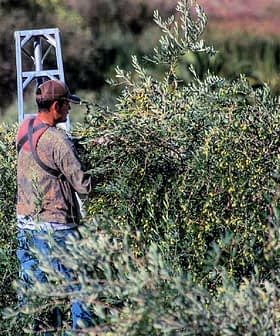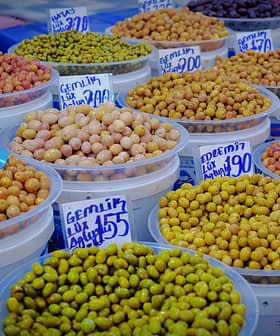Prices Continue to Break Records in Spain Ahead of Dismal Harvest Outlook
However, timely rain paired with stagnant global demand and an increasing number of olive groves entering maturity could reverse the price trends.
 Barcelona, Spain
Barcelona, Spain  13.6K reads
13.6K readsOlive oil prices in Spain are currently at record highs, with factors such as rising production costs, poor harvests, and global demand contributing to the increase. However, it is expected that prices will eventually decrease in the long term as new olive groves mature, consumption stabilizes, and climatic conditions return to normal.
Olive oil prices at origin continue to rise in Spain, smashing records. However, several factors could come together in the long term, dramatically lowering prices.
According to Poolred, the online olive oil price database run by the Andalusian government, the average price of olive oil at origin is €5,516 per ton, about €500 more than last month.
We are living in an unprecedented situation. There have never been olive oil prices at origin like we are seeing now.
Meanwhile, International Olive Council data show that prices in Jaén, Spain’s benchmark market, have risen steadily since June 2020, with a sharp acceleration in recent months.
“We are living in an unprecedented situation,” Juan Vilar, a strategic consultant for the sector, told Olive Oil Times. “There have never been olive oil prices at origin like we are seeing now.”
See Also:Olive Oil Prices Rising Faster than Inflation in Italy“In addition, it becomes more unprecedented because the prices move upwards every day,” he added.
Vilar is not alone in his surprise. “In 20 years in the industry, I have never seen these prices,” Vito Martielli, an oilseed analyst at Rabobank, told the Financial Times.
Vilar said the closest prices ever came to this point was in the 2017/18 crop year, and even then, prices remained 35 percent lower than they are now.
He has identified three reasons olive oil prices at origin continue to soar: rising production costs, Spain’s increasingly hot and dry climate and global demand exceeding production.
“The first factor was the initial increase in inputs,” he said. “There was a very high increase in the price of chemicals, energy, water, electricity, diesel and fertilizers. These increases are directly passed on to the price of olives and, therefore, to the price of oil.”
Along with rising input costs, Vilar said the historically poor harvest in the 2022/23 crop year has also put upward pressure on prices.
According to the latest data from Spain’s Ministry of Agriculture, Fisheries and Food, production reached 736,000 tons, the lowest yield since 2012/13.
Producers and officials blamed a combination of hot weather during blossoming and the historic drought for the low harvest.
Compounding the pressure on prices, hot and dry weather across Spain portend another low harvest in the world’s largest olive oil-producing nation.
While it is still too early to tell how the 2023/24 crop year will evolve, reports are trickling in of damage to olive tree blossoms in Andalusia, the world’s largest producing region, akin to what happened last May. Vilar added that only rain this month or in the autumn would save the harvest.
“So the climate is a long-term factor, and only if it rains will the expectations of next year’s harvest improve,” Vilar said. “And from there, prices would drop at least 20 to 25 cents at origin. If it rains in May, the escalation of prices at origin and destination could be stopped.”
The third factor cited by Vilar is the tension between domestic and global olive oil consumption. Due to poor harvests across the western Mediterranean, Spain is increasingly fulfilling demand from markets abroad, further putting pressure on prices at home.
The International Olive Council forecasts that global olive oil consumption will reach 3.05 million tons in the 2022/23 crop year, while production will be 2.73 million tons. While some countries have olive oil stocks to dip into, these are barely expected to cover the shortfall.
If it does not rain in May, olive oil prices are likely to continue rising through the coming 2023/24 crop year, breaking records weekly.
However, Vilar said prices are likely to fall in the long term as 4,000 new hectares of olive groves planted globally in recent years enter maturity, resulting in annual production of more than 4 million tons; olive oil consumption continues to stagnate or rise slightly; and climatic conditions return to normal, and producers adapt to the impacts of climate change.
“These three factors would combine to lower prices at origin,” Vilar confirmed. Still, he added that until the drought gripping the western half of the Mediterranean basin breaks, “prices will not stop rising.”
While there is concern that rising prices in producing countries will continue the trend of stagnating consumption, not everyone is concerned.
Vilar said consumers in Canada, Germany, Brazil, the United States and other middle-income and wealthy countries would “continue to consume olive oil because they are used to paying €10 [or more] at the supermarket without any problem.”
David Granieri, president of Unaprol, Italy’s olive oil producer association, celebrated rising prices at origin.
“The increase in prices, especially in Spain, is good news because finally, perhaps, the race to the bottom that has damaged all European producers and depressed the whole market is over,” he told the Financial Times.
“In these conditions, we believe that the producers who in recent years have multiplied their efforts to protect biodiversity and produced high-quality oils can finally be valued as they deserve,” he concluded.
Share this article









